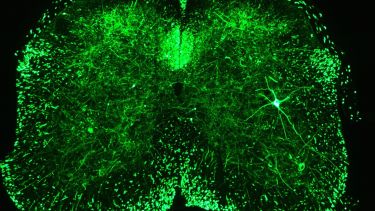Sensory and developmental neuroscience
Our multidisciplinary and innovative approach to neuroscience research allows us to explore how sensory inputs are detected and processed by the nervous system in health and disease.

Our research
The sensory systems in the human body allow us to experience the world around us through light, sound, touch, smell and taste. The human brain enables us to perceive and understand our own bodies and the environment.
At the Neuroscience Institute, we use a multidisciplinary research approach to study how sensory systems and brain-integrating systems develop, and how sensory inputs are detected and processed by the nervous system in health and disease.
We have experienced researchers working on hearing, balance, vision, olfaction, brain-integrating systems and pain. Our teams bring together expertise in electrophysiology, imaging and computing, combined with sophisticated in vivo models and analysis of human tissues. We have started to bridge the gaps between molecular biology, developmental neurobiology, systems physiology, and behaviour. These advances have important applications to health, particularly for the many people affected by developmental and sensory disorders including nerve injury, hearing loss, chronic pain and autism.
We are also investigating the mechanisms leading to age-related deterioration of sensory function and how this can be prevented.
Hearing and balance
We study development, function and ageing of the vertebrate auditory and vestibular systems. This research involves analysis at multiple levels, ranging from single genes to cells, organ systems and in vivo models.
Our current research shows how electrophysiological activity during development shapes the differentiation of mammalian hair cells and reveals subtle interactions in the development of the mechano-electrical transduction machinery and of the ribbon synapses that relay information to the nervous system. This is associated with the exquisite mechanisms for tuning in hair cells and their afferent neurons along the ionotopic gradient.
We are exploring the application of cell therapies to repair nerve damage to the inner ear and the study of genetic models of human deafness and balance in mice and zebrafish. Innovative light microscope techniques are also being used to reveal detailed images of the inner ear sensory structures.
Hearing Research Group at the University of Sheffield
Vision
We work with fruit fly and zebrafish visual systems, utilising genetic tools, optical imaging, electrophysiology and computational modelling to study visual information processing from photoreceptors to neural networks and animal behaviour. We are interested in how visual systems maximise information encoding and transfer, how top-down processes influence visual processing, and how the brain detects useful visual features in order to recognise objects in the environment and guide behaviour appropriately.
Olfaction
We use multiphoton imaging, electrophysiology and behaviour to study the sense of smell (olfaction) in fruit flies, a genetically tractable model organism whose olfactory system is remarkably similar to our own. We are interested in how information about odours in the environment is encoded in the brain and how olfactory circuits wire themselves up to enable these coding strategies. Our current research shows how an animal’s ability to form odour-specific associative memories depends on the particular ways in which sensory information is encoded in central brain circuits.
Brain-integrating systems
We work with sophisticated in vivo models to understand the development of the brain, including the hypothalamus and the cerebellum. These regions let us sense and respond to our own bodies and the environment. The hypothalamus is key to the body’s wellbeing, acting as the master controller of homeostasis.
Our current research provides understanding of homeostasis in health as well as in wide-ranging disorders, including autism, anxiety and addiction, and in ageing. Developmental neuroscientists work closely with developmental biologists in the Bateson Centre and the School of Biosciences.
Pain
Chronic pain is a debilitating experience, affecting patients across all clinical disciplines. It often results in serious co-morbidities and psychological disorders such as anxiety and depression.
Chronic pain is a major public health issue, impacting on health, quality of life, employment and the wider economy. However, its pathogenesis is still poorly understood, which limits treatment options.
We aim to understand the mechanisms of chronic pain and improve its treatment. We have an interdisciplinary team of scientists and clinicians – with extensive expertise in molecular biology, in vitro and in vivo modelling, treatment of patients with pain and access to a unique archive of patient tissue samples.
We collaborate with researchers who have expertise in pre-clinical and human imaging, mass spectrometry, proteomics and biomaterials. Our combined expertise enables us to develop an improved translational strategy to further the understanding of chronic pain and develop novel therapies.
Research expertise and principal research areas:
- Mechanisms of neuropathic and inflammatory pain
- Pain from bladder and bowel
- Cancer-induced bone pain
- Mechanisms of orofacial pain
- Molecular mechanisms of sensory neuron dysfunction in pain
- Pre-clinical evaluation of migraine
- Psychological, social and gender differences in pain perception
- Botulinum proteins for long-lasting alleviation of pain
- Nerve repair and regeneration
